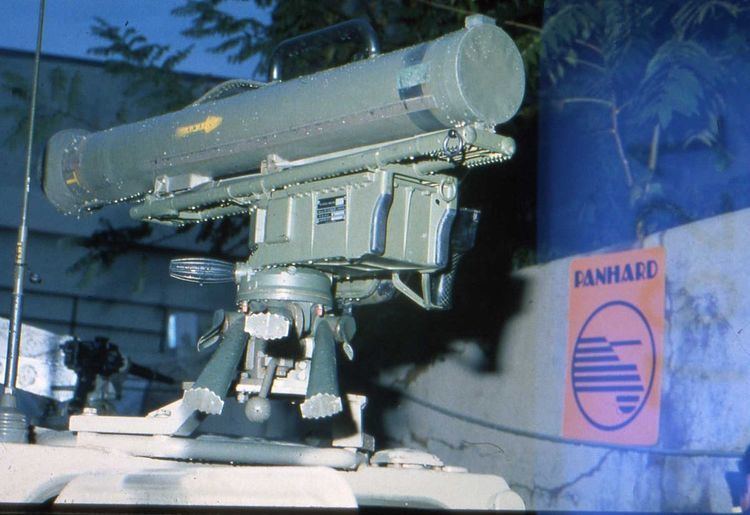MILAN (French: Missile d´infanterie léger antichar; English: Light anti-tank infantry missile, milan(e) is French for kite) is a European anti-tank guided missile. Design of the MILAN started in 1962, it was ready for trials in 1971, and was accepted for service in 1972. It is a wire guided SACLOS (semi-automatic command to line-of-sight) missile, which means the sight of the launch unit has to be aimed at the target to guide the missile. The MILAN can be equipped with a MIRA or MILIS thermal sight to give it night-firing ability.
MILAN is a French / German missile that has been license-built by Italy, Spain, Britain and India. Because it is guided by wire by an operator, this missile can avoid most countermeasures (flares, chaff and radio jammers). The drawbacks are its short range, the exposure of the operator, problems with overland powerlines and a vulnerability to infrared jammers such as Shtora that can prevent the automatic tracking of the missile's IR tail light.
MILAN 1: Single, main shaped charge warhead (1972), calibre 103 mmMILAN 2: Single, main shaped charge warhead, with standoff probe to increase penetration (1984) – see photo to right, calibre 115 mmMILAN 2T: Single main shaped charge, with smaller shape charge warhead at end of standoff probe to defeat reactive armour (1993)MILAN 3: Tandem, shaped charge warheads (1996) and electronic beaconMILAN ER: Extended range (3,000 m) and improved penetrationThe later MILAN models have tandem HEAT warheads. This was done to keep pace with developments in Soviet armour technology – Soviet tanks began to appear with explosive reactive armour, which could defeat earlier ATGMs. The smaller precursor HEAT warhead penetrates and detonates the ERA tiles, paving the way for the main HEAT warhead to penetrate the armour behind.
Afghanistan – Afghan National Army Armenia – Armed Forces of Armenia Brazil – Brazilian Army Belgium – Belgian Army: Infantry weapon; to be replaced by Spike-MR missile. Chad – Chadian Ground Forces: Infantry weapon. Cyprus – Cypriot National Guard 45 launchers Estonia – Estonian Defence Forces Egypt – Egyptian Army: Mounted on light vehicles. 220 units are used. France – French Army: Infantry and vehicle-mounted weapon. Will be replaced by Missile Moyenne Portée (MMP) from 2017. Germany – Bundeswehr: Mounted primarily on Marder and TPz Fuchs fighting vehicles; to be replaced by EUROSPIKE. Greece – Hellenic Army 400 Launchers India – Indian Army: Infantry and vehicle-mounted weapon. Around 30,000 built under license by Bharat Dynamics. The Indian Army has also spent close to US$120 million on 4,100 new MILAN-2T ATGMs. Iraq – Iraqi Army: One reportedly hit a British Challenger 2 MBT during the early stages of Operation Telic along with multiple rocket-propelled grenades. The tank survived the attack. Kurdistan – Peshmerga: 30 launchers and 500 missiles, delivery in two portions was announced on August 31, 2014 by German Bundeswehr. These are 1980s Milan2 replaced by later models but still in storage. Used by the Kurds to stop ISIL vehicle-borne improvised explosive devices (VBIEDs). Usage of Milan2 against Daesh (IS) VBIED in Iraq and Syria 2015/16 see here. Italy – Italian Army: Infantry weapon. Built under license by Oto Melara; Total of 714 launchers with 17,163 missile delivered in 1990. 807 MILAN 2T ordered in 2004 and delivered in 2005 (SIPRI). Kenya – Kenyan Army: Infantry weapon. Lebanon – Lebanese Army Libya – Libyan National Army Macedonia - Army of the Republic of Macedonia Mauritania – Mauritanian Army Mexico – Mexican Army (Ejército Mexicano): Mounted primarily on Panhard VBL scout cars; at least 16 launchers and several hundred missiles are available. Morocco – Royal Moroccan Army Pakistan – Pakistan Army Portugal – Portuguese Army; Portuguese Marines PKK : As per the Der Spiegel, PKK acquired the MILAN anti tank missiles South Africa – South African Army: 375 missiles. Spain – Spanish Army: Upgraded to MILAN 2/2T. Syria – Syrian Army: About 1000 missiles used in the anti-vehicular role. Free Syrian Army: Some captured. Tunisia – Tunisian Armed Forces: 120 missiles. Turkey – Turkish Army Uruguay – Uruguayan Army Yemen – Yemeni security forces Australia – Australian Army: Was used by infantry and mounted on vehicles. The Australian Army withdrew the MILAN from service in the early 1990s. The ADF now fields the FGM-148 Javelin system. Ireland – Irish Army: Infantry weapon; replaced by the FGM-148 Javelin. Singapore – Singapore Army: Replaced by the Israeli Spike. UNITA: 150 missiles. United Kingdom – British Army; Royal Marines – While primarily an infantry weapon, it was also used in the FV120 Spartan MCT turret. Over 50,000 missiles were purchased for use in the British Armed Forces. The MILAN was deployed against Argentine bunkers in the Falklands conflict and later against T-55s during the Persian Gulf War. It was replaced by the FGM-148 Javelin in mid-2005.
